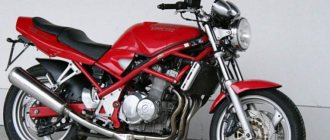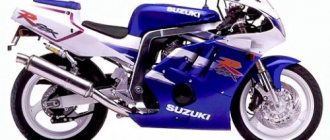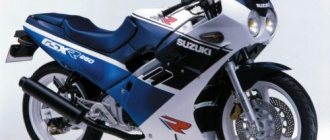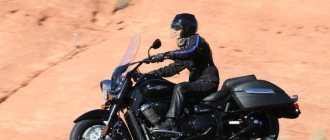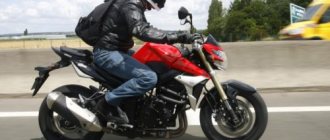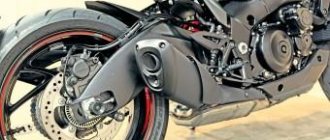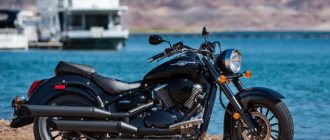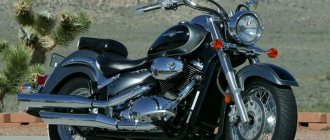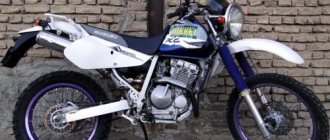Review of the Suzuki RF 600 (RF600R) motorcycle
Contrary to the class to which it belongs, I took the moped mainly for urban use, which the moped does well. At first, the weight was a little scary: dry 195kg, loaded 220kg. And in reviews about RFki (in which 600ka, by the way, does not appear), everyone writes as one: very heavy, difficult to shift, not suitable for the city. It was repulsive. In fact, the weight is only felt for the first couple of days. Then you get used to it and don’t notice that you are riding on a barge. Regarding the barge: according to the mirrors, it is almost a meter wide, 2.15 m long, but it fits through most row spacings, avoids traffic jams, saves time. Weight becomes an advantage as speed increases: the moto is very stable and not susceptible to side winds even at high speeds.
At first, the weight was a little scary: dry 195kg, loaded 220kg. And in reviews about RFki (in which 600ka, by the way, does not appear), everyone writes as one: very heavy, difficult to shift, not suitable for the city. It was repulsive. In fact, the weight is only felt for the first couple of days. Then you get used to it and don’t notice that you are riding on a barge. Regarding the barge: according to the mirrors, it is almost a meter wide, 2.15 m long, but it fits through most row spacings, avoids traffic jams, saves time. Weight becomes an advantage as speed increases: the moto is very stable and not susceptible to side winds even at high speeds.
Brakes: any brake driver will say about the brakes: sluggish and not informative. They say it can be solved with reinforced hydraulic lines, we will check this next season. But overall the brakes are enough for me. There are two Nissin two-piston calipers at the front, and a Tokico two-piston caliper with opposed pistons at the rear. If the front still slows down quite tolerably, then the rear either does not brake, or blocks the rear wheel and still does not brake. Suspension: regular Showa fork at the front, progressive fork at the rear with adjustable preload. Soft. Sports people won’t like it because it doesn’t hit the butt and doesn’t break the back. However, it does its job well. The bike absorbs bumps very well, is very smooth and comfortable. I admit, sometimes it breaks through, but as a rule, these irregularities are clearly visible on the road and are avoided, or, in extreme cases, you can slow down, since the moped can accelerate. Engine: in-line twin-shaft 16-valve four. Without any cool timing systems, such as VTEC or VC. He doesn’t need it, the pickup at 9000 already feels great. It spins up to 13500, cut-off at 14000. According to the characteristics, it was said at the beginning: 105 forces, 65 Nm of torque. This is enough to accelerate my 220kg, +80kg, actually, me and about the same amount of kg of the passenger. By the way, the presence of a passenger does not affect the dynamics. It only affects the fact that at first with a passenger the engine tries to lift the front wheel, without a passenger it behaves less extreme - the weight distribution takes its toll. The engine is a carb, the Mikuni BST is not everyone’s favorite carb, which few motorcycle services undertake to tune. However, with direct hands, all problems are solved and the carbs do not remind of themselves for at least a couple of seasons. It doesn’t bother me, but there’s no extra electrics. If you don’t turn the engine like hell, there won’t be any oil. I drive quite dynamically and quickly, and often unscrew it. But I didn’t notice the oil-guzzling thing. Regarding appetite: in the city it turns out to be 6.5-7l/100km, on the highway at speeds up to 160 - 5l, further - more, of course.
They say it can be solved with reinforced hydraulic lines, we will check this next season. But overall the brakes are enough for me. There are two Nissin two-piston calipers at the front, and a Tokico two-piston caliper with opposed pistons at the rear. If the front still slows down quite tolerably, then the rear either does not brake, or blocks the rear wheel and still does not brake. Suspension: regular Showa fork at the front, progressive fork at the rear with adjustable preload. Soft. Sports people won’t like it because it doesn’t hit the butt and doesn’t break the back. However, it does its job well. The bike absorbs bumps very well, is very smooth and comfortable. I admit, sometimes it breaks through, but as a rule, these irregularities are clearly visible on the road and are avoided, or, in extreme cases, you can slow down, since the moped can accelerate. Engine: in-line twin-shaft 16-valve four. Without any cool timing systems, such as VTEC or VC. He doesn’t need it, the pickup at 9000 already feels great. It spins up to 13500, cut-off at 14000. According to the characteristics, it was said at the beginning: 105 forces, 65 Nm of torque. This is enough to accelerate my 220kg, +80kg, actually, me and about the same amount of kg of the passenger. By the way, the presence of a passenger does not affect the dynamics. It only affects the fact that at first with a passenger the engine tries to lift the front wheel, without a passenger it behaves less extreme - the weight distribution takes its toll. The engine is a carb, the Mikuni BST is not everyone’s favorite carb, which few motorcycle services undertake to tune. However, with direct hands, all problems are solved and the carbs do not remind of themselves for at least a couple of seasons. It doesn’t bother me, but there’s no extra electrics. If you don’t turn the engine like hell, there won’t be any oil. I drive quite dynamically and quickly, and often unscrew it. But I didn’t notice the oil-guzzling thing. Regarding appetite: in the city it turns out to be 6.5-7l/100km, on the highway at speeds up to 160 - 5l, further - more, of course.
At the age of 17, I bought myself this 600 cc 94 and I think that it’s not bad to take it as my first bike. 600cc is already a speed of over 200, like a full-fledged motorcycle in plastic, and there is enough power (like 100 mares) so that you don’t have to downshift when overtaking, and it’s also normal to ride with a passenger (you don’t feel disadvantaged that the motorcycle is moving slowly)
Moreover, Rfka is such a mot after which you can easily saddle motorcycles that are more powerful or larger, for example, I myself am thinking about how soon I should get a bus or, for now, ride a Thunderace
Of the advantages of the 600 (I consider these advantages), as the first-born, I can say that the motorcycle refuses to lift into the spark plug from the gas, just as in principle it does not willingly do this from the clutch.
But on the other hand, if you are crazy, you will be bored, and even more so, what is the difference between 600 and 900 cubes? 300 cubes don't solve anything
I think take 900 because for the first year or month or maybe just a week you will curb it, and then these 900 cubic meters will roll you around for years until you want something faster, softer or more comfortable
It was 400 ka. I got tired of it during the season. 600 cc two seasons. Break for two seasons and for the third RF900. H.z. 600 was enough for me. It was even more interesting. 900 potential is difficult to squeeze out. and out of 600 I did it. Maybe my brain has grown, but now I would change the 900 to the 600. The 900 drives cooler, but the tachometer does not reach the red zone, there is no such roar as on the 600, so the ride seems more boring, although the speed and dynamics are at their best. 120 mph is about 5 thousand in fifth gear at 900. The speed is decent, but the feeling in the engine is that you’re standing still... 600 at this speed will be louder. In general, 600 is a completely justified choice for all ages for the city + highway, and 900 highway + city.
text from Motorreview No. 1, 2004:
Vladimir Zdorov,
photo:
Fot'n'RacerSuzuki RF400RV: 398 cm3, 53 hp, 180 km/h, $3500
Kawasaki ZZ-R400: 399 cm3, 53 hp, 180 km/h, $3600
Again in the crosshairs of the 400 comparative test. This time, thoroughbred sports tourists, the best-selling representatives of this class. The models are almost identical in their capabilities and characteristics, so it is very, very difficult for the average consumer to choose between them. If you are not one of those who buy according to the principle of “whatever catches your fancy,” then you will probably be interested in a number of distinctive nuances of these devices.
Clothes decide everything It’s no secret why “400s” have become the most popular class of motorcycles in our country. Increasing prices, acceptable driving performance and traditional Japanese reliability are the components of successful promotion. And the folk trail does not grow into second-hand stores. But if previously the consumer, without understanding, grabbed what looked smarter, now give him certain models, and the younger, the better. One thing, perhaps, has remained unchanged - those suffering before the “Japanese” still gravitate towards “dressed” motorcycles. That is why the share of sport bikes and sports tourists has increased in the market of used foreign cars. A good confirmation of this is our wards, Suzuki RF400RV and Kawasaki ZZ-R400, which are sold very actively in our country. And although the models belong to the category of sports “tourists,” many novice motorcyclists sign them up as sportbikes behind their backs. Which, however, is not surprising: it is very problematic to detect the tourist component of these devices packed in plastic in static conditions.
Compromises Bias is not the best of human qualities, but I can’t help it: I like the Suzuki design, and that’s it! I’ll start with it... A person who does not work with motorcycles from morning to evening will hardly be able to distinguish the youngest of the family from its larger-sized brothers - the model is identical in size to the 600 and 900 cc versions. This is certainly a good thing for our market, because the average Japanese in our country is an 18-year-old boy who only dreams of speed. This is a rare case when a domestic Japanese model meets European ergonomic requirements. The pilot's landing position on the RF is very specific, a kind of intermediate option between sports and touring. That is, compromise is a word that most accurately describes the essence and purpose of a motorcycle, literally woven from these compromises. So, despite its 100% sportbike appearance, the Susa has a steel frame, which, as you yourself understand, does not add grace to it. But it reduces the cost. But we must pay tribute to the designers, this device is successfully camouflaged and painted in the color of plastic. The engine is the highlight of the motorcycle. And it is not at all simple - it is equipped with a VC (variable valve control) variable valve timing system. Three years after the debut of the regular RF, namely in 1996, the gentlemen from Suzuki, apparently tired of reading in various meticulous magazines about the insufficient dynamics of the model, and released a modification of the RF400RV, equipped with this useful and fashionable mechanism. The upgrade did not in any way affect the increase in power characteristics, but the maximum performance was more pronounced, and the traction at low speeds improved. To be honest, it was not possible to achieve perfect results. Only on paper did the engine receive the “pickup” that is so important when riding medium-sized motorcycles. In fact, he just became normally high-torque. But what is much more important is that at high speeds the engine no longer twists into a tube due to strain. However, all this had to be tested on a specific specimen.
You may not be a “tourist”... It’s time to look at your opponent, who, by the way, is not the youngest in the ZZ-R family. Don't forget that there is a fairly successful 250cc version of the device. So, Kawasaki ZZ-R400. The external perception of the model is the same as in the case of Suzuki - you can’t immediately tell about the real engine volume: the model is identical in size to the ZZ-R600. Of course, there are nuances that the trained eye of an expert will highlight even at a hundred-meter distance, but for the average consumer they are invisible. The pilot's position is significantly different from that of the Suzuki. Firstly, the forward tilt is more pronounced here. There is an attempt to bring the landing closer to a sportier one, naturally, without the extremes of the ZXR400. Secondly, the distance to the pegs is slightly greater, which gives some relief to the lower limbs of yours truly. At the same time, the seat height of 780 mm suggests that with more or less serious inclinations, the footrests will contact the asphalt too early. As for the ease of boarding a passenger, he will have a surprisingly good time here. Although RF is still more comfortable for the second number, especially in terms of legroom. Despite the fact that the mirrors are spaced quite widely, the visibility in them is poor. But on the Suza there are no such problems, and the situation behind the device is perfectly visible. But here there is a typical “Kawasaki” gadget - hooks for luggage that are retractable into the lining - beautiful and practical. There was no skimping on the element that is most vital for handling - the frame - it is made of aluminum alloy. Well, it’s time to test the motorcycles in action, and I’ll start, forgive my bias, with Suzuki...
The tops can't, and the bottoms can't either . Perhaps the most accurate word to describe the dynamics of the RF would be “smooth.” This is exactly how acceleration proceeds leisurely and unhurriedly. Any bright “picks” promised by the VC system are practically not noticeable. I don’t know, I wasn’t particularly delighted with this “trick.” Even if they told me that she wasn’t here, I would believe it. Although the red-painted cylinder head evokes thoughts of a complex engine. Only one question remained unresolved for me. If the “charged” version drives like this, then what about the regular RF? Naturally, everything is relative. “Smooth” in my motorcycle values, which have been fairly diluted by the numerous liter sportbikes I’ve tested, means about 4.5 seconds to 100 km/h. Of course, very few, and at the same time very expensive, sports cars can boast such characteristics. But we, motorcyclists, are already accustomed to indicators of less than three seconds to “hundreds”. Alas, after 150 km/h acceleration weakens sharply. Nevertheless, the Suzuki, although lazy, accelerates to 180 km/h. Next, the electronic speed limiter comes into effect, once again emphasizing the domestic Japanese origin of the model. The device handles very confidently in a straight line and at such speeds, but, alas, there is no need to talk about any dynamics. Moreover, sixth, fifth and, perhaps, even fourth gears are here, rather, to maintain established speeds than for acceleration. If the unfulfilled ambitions of the racer haunt you, you will have to “hang” in the first three gears, forgetting that the motorcycle is equipped with a six-speed gearbox.
Trying to imagine yourself as a cool stuntrider will look completely ridiculous. The geometry of the front suspension does not allow the motorcycle to be placed on the front wheel. As for driving in the rear, the situation is as follows... Having made the engine roar heart-rendingly at almost 11,000 rpm and mercilessly throwing the clutch, from the tenth time I managed to drive 15 meters in the spark plug... Then the rev limiter worked, and, as a result, instead of a soft landing, there was a dull blow to the front fork, followed by its breakdown. So the sportbike components in the model are minimal. No, of course, if the spirit of an unrealized mechanic is also alive in you, go for it... However, there is no less positivity in RF. Excellent wind protection is a kind of bonus for the over-developed plastic cladding, and the front fork, which annoys me with deep dives during hard braking, perfectly “swallows” all sorts of road rubbish. Only the longitudinal cracks force you to strain a little, in them the motorcycle begins to live its own life - hello to the steel frame.
The peculiarities of the weight distribution of the device are such that the rear brake is quite appropriate here, and in general the braking dynamics left a very pleasant impression. Despite its relatively modest weight (186 kg), in corners I encountered behavior so well known to me from the habits of my older 900 cc sister. “Sousa” strongly resists deep bends. It has to be forced into a turn. After driving like this for a while, you begin to get used to it and stop feeling the noticeable inertia of the car when cornering. It seems like 400 cm3, but with active driving, fuel consumption easily reaches 8 l/100 km, so a 17-liter tank is often not enough for such an appetite.
With the grace of a hippopotamus Before the impressions disappear, like migratory birds, I immediately change to Kawasaki. Having mentally prepared myself for the fact that I would now have to eat the same dish prepared by another chef, I was somewhat surprised. A rather similar acceleration to 8000 rpm suddenly turned into, albeit not so pronounced, but still into “catch.” Having habitually reached the “maximum speed” of 180 km/h, strangled by the cunning Asians, I discovered that the wind protection was slightly better than that of the RF. And in general, after 150 km/h the device looks somewhat livelier than its competitor. Despite the more progressive frame design, the Kava demonstrated the grace of a hippopotamus in turns, and after a very hearty meal. In general, by modern standards, 195 kg of dry weight for a 400 cm3 motorcycle is simply indecent. Therefore, driving on winding roads is clearly not the ZZ-R's element. The downside: considerable mass contributes to good stability when driving on long straights. And such serious aerodynamic interference as oncoming trucks have almost no effect on the chosen course. Indeed, in front of me is a small-capacity “tourist”. Moreover, a relatively large 18-liter tank also works for this image. And fuel consumption turned out to be very moderate: on average, during the test the motorcycle consumed about 6 l/100 km.
The suspensions, like those on the Suza, are tuned for a comfortable ride. At the same time, as a payment for convenience, deep dives of the front fork are noticeable during any serious braking, as well as an almost complete loss of damping properties when driving with a passenger. The solution here seems to be this: the passenger should be a slender girl weighing about... hmm... well, let's say, no more than 45 kg... I myself know that such people are “found” mainly in fashion magazines. But even an individual worthless in everyday affairs, such as a motorcycle journalist, has the right to dream. The scrape of the left footrest on the asphalt confirmed my fears that they were not located high enough from the ground. On the other hand, passenger legroom is noticeably greater than on the RF. A cold mind resisted the reflexive actions of the right hand, which in vain was twisting the throttle inside out (the left hand was busily throwing the half-squeezed clutch at that time), but what can you do, a test is a test... The Zizer was a little more fun than the Suza went in the back. This procedure is also much easier for him. And in general, it is possible to drive on the rear wheel for quite a decent 50-60 meters in this case. But I’ll emphasize once again that such modes for 400 cc engines are complete violence and do not pass without a trace. Anyone in doubt should read the report on the operation of the Suzuki SV400 in the last issue.
Probably the best word to describe the difference between the cars is a little. I'll resort to him again. The gearbox works a little harder than on the RF, but overall it’s quite decent, especially for Kawasaki, which is “famous” for constant “jambs” in these units. As for braking performance, the cars are very similar. There are minor differences, rather at the level of nuances... Suzuki is a little better.
One rides, the other gallops When I was testing motorcycles, a strange allegory came to my mind. After all, these models are nothing more than reusable tour packages. Moreover, their market value is very attractive, and therefore the vouchers can be assigned the status of “hot”. In these cars, in fact, you can go on a trip, both long and short. The models have proven their tourist qualities 100%. But which ticket (read – device) to choose? It was not possible to identify a clear leader, nor, indeed, an outsider. When choosing a particular motorcycle, the question of external perception arises (as well as the tour operator’s office). Here Kawasaki is probably preferable. Because its design is still a little more modern. And the engine, despite the nominal “frailty” of a whole “mare” in comparison with the Suzuki, actually looks more fun. On the other hand, RF can respond with a more clearly operating gearbox and brakes. And we certainly shouldn’t forget about providing motorcycles with spare parts: both models are analogues of their 600 cc versions, so the only difficulties will be when ordering motor parts. As a result, the competitors' scores are almost equal. The final choice should be based on the overall condition of the particular vehicle, as well as personal preferences, which, despite everything, make me like the Suzuki RF400 RV. After all, some people like to go to Turkey every year, while others like to go to Egypt.
Kawasaki ZZ-R400: 399 cm3, 53 hp, 180 km/h, $3600 Previous photo Next photo
Suzuki RF400RV: 398 cm3, 53 hp, 180 km/h, $3500 Previous photo Next photo test evaluation pros/cons
Kawasaki ZZ-R400 Dynamics This is indicated by a slight “pickup” after 8000 rpm Comfort Not yet a “Cadillac”, but no longer WV Ergonomics I want to be an athlete Brakes I hardly need more Drive Spin me! What a pity?
Suzuki RF400 RV Dynamics And I'm not in a hurry Comfort The main thing is not to fall asleep Ergonomics A full-fledged “tourist” Brakes For such dynamics there is more than Drive What are you talking about?
Kawasaki ZZ-R400 + Very comfortable. Rigid frame, informative brakes. The power unit is characterized by elasticity of operation, and at the same time there is a “sporty” note at high speeds. The smooth operation of the checkpoint is a pleasant exception to the rule. Suzuki RF400 RV + Excellent ergonomics and wind protection emphasize touring capabilities. The traction characteristics of the motor are impressive; the VC system allows you to call this device a motorcycle with a twist. Powerful brakes. Kawasaki ZZ-R400 – Suspension tuning eliminates active driving rhythm and somewhat spoils the impression of handling, especially in corners. The front “telescope” sometimes breaks through potholes. Excess dry weight affects acceleration dynamics. Suzuki RF400 RV – The car provokes high-speed driving, but the soft chassis does not allow you to do this to the fullest. The steel frame and puncture-prone front fork can cause you to fall over when cornering. High-frequency vibrations from the power unit are also noticeable on the footpegs and steering wheel. Suzuki RF400RV parameters: 398 cm3, 53 hp, 180 km/h, $ 3500
Options Model Kawasaki ZZ-R400 Suzuki RF400 RV Debut/start of production, 1990 1996 Dry weight, kg 195 186 Curb weight, kg 220 209 Dimensions, mm 2070 x 695 x 1175 2115 x 700 x 1180 Base, mm 1430 1430 Seat height, mm 780 775 Ground clearance, mm 120 115 Front fork angle 24 23 Engine 399 cm3, 4-stroke, 4-cylinder, DOHC, 4 valves, liquid cooling 398 cm3, 4-stroke, 4-cylinder, DOHC, 4 valves, liquid cooling Dimension, mm 57.5 x 38.5 56 x 40.4 Supply system 4 Keihin CVKD30 carburetors Mikuni BST 32 Power, hp / rpm 53/11000 53/11000 Torque Nm / rpm 37/10000 38/9500 Transmission 6-speed gearbox, multi-plate wet clutch, chain Frame diagonal, aluminum alloy single, steel Front suspension telescopic fork, Ø 43 mm, travel 130 mm telescopic fork, Ø 43 mm, travel 120 mm Rear suspension pendulum, monoshock absorber, stroke 120 mm pendulum, monoshock absorber, stroke 125 mm Front brake 2 discs Ø 298 mm, 4-piston caliper Rear brake 1 disc Ø 240 mm, 2-piston caliper Front wheel 120/60-17 120/70-17 Rear wheel 160/60-17 Gas tank volume, l 18 17 Maximum speed, km/h 180 Fuel consumption, l/100 km 3,7 4,9
